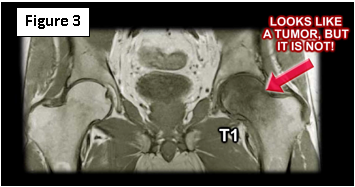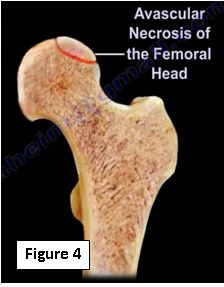Transient osteoporosis of the hip is an uncommon condition. The patient will experience a sudden onset of pain that intensifies with walking or other weight-bearing activities (Figure 1). The pain associated with transient osteoporosis will increase over time and may become disabling. There may be groin pain associated with the condition.

Transient osteoporosis most often occurs in the hip joint but can also affect other joints such as the knee or the ankle. With transient osteoporosis of the hip, the femoral head loses its density and strength.
It often occurs in middle-aged men and in women in the late stages of pregnancy (third trimester) or in the early post-partum period.
The radiograph typically shows diffuse osteopenia and bone scan shows increased uptake through the entire head and neck of the femur (Figure 2). X-rays and bone scan may be normal despite the hip pain. The x-ray will usually show that the joint space is spared.

MRI will show complete replacement of the marrow on T1 (Figure 3) and hyperintense marrow on T2 (intense bone marrow edema).

The symptoms may gradually subside and usually end in about 12 to 15 months. Bone strength in the hip returns to normal in the majority of people.
Differential diagnosis of transient osteoporosis of the hip
Avascular necrosis of the femoral head is the death of a segment of bone in the femoral head due to interruption of the blood supply (Figure 4). The femoral head may show a crescent shaped segment of dead bone. AVN usually occurs at the superior anterior aspect of the femoral head. Other differential diagnoses include metastatic bone disease, femoral neck stress fractures, infection, or true osteoporosis.

The difference between transient osteoporosis and AVN is that transient osteoporosis involves the entire femoral head and neck while AVN will usually involve the superior anterior aspect of the femoral head. Early differentiation from the more aggressive conditions is important to avoid unnecessary treatment. Transient osteoporosis is not true osteoporosis.
Treatment
A patient with transient osteoporosis should have a period of partial weight-bearing and should ambulate using crutches. The patient is usually given NSAIDs. Transient osteoporosis is a self-limiting disease that is not a tumor, not an infection, not osteonecrosis and not a true osteoporosis.
For more information, visit my YouTube Channel:
